CPCCBC5009A Assessment 4: Analysis of Building Services for Apartments
VerifiedAdded on 2022/12/28
|15
|2342
|23
Report
AI Summary
This report, based on the CPCCBC5009A assessment, analyzes the building services for a proposed commercial and residential development. It begins with a detailed examination of a vented single-stack plumbing system, including its justification and a stack-work diagram. The report then moves on to the hot and cold water reticulation system, followed by a lighting and wiring diagram for a typical apartment floor. A significant portion is dedicated to evaluating viable hot water systems, specifically focusing on solar hot water systems, comparing active and passive systems, and considering factors influencing the choice, along with incentives and costs. Finally, the report compares individual air conditioning systems and building-wide systems, discussing their impact on power load, considerations for individual tenants, and fire safety issues. The report concludes with a summary of the findings, providing valuable insights into various building systems and their implications.

Running head: CPCCBC5009A: ASSESSMENT 4 1
CPCCBC5009A: Assessment 4
Institutional affiliation
First name Last name
CPCCBC5009A: Assessment 4
Institutional affiliation
First name Last name
Paraphrase This Document
Need a fresh take? Get an instant paraphrase of this document with our AI Paraphraser
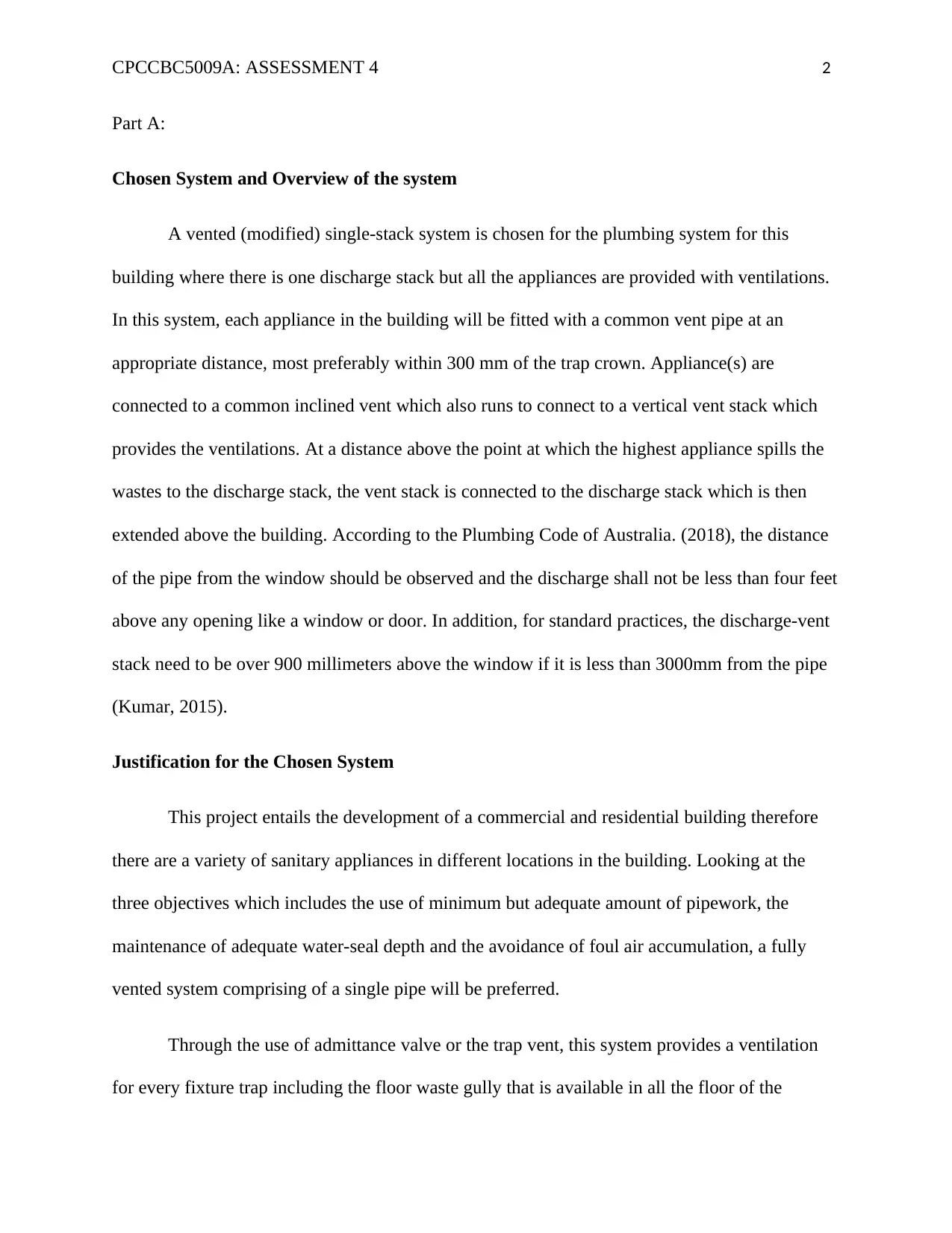
CPCCBC5009A: ASSESSMENT 4 2
Part A:
Chosen System and Overview of the system
A vented (modified) single-stack system is chosen for the plumbing system for this
building where there is one discharge stack but all the appliances are provided with ventilations.
In this system, each appliance in the building will be fitted with a common vent pipe at an
appropriate distance, most preferably within 300 mm of the trap crown. Appliance(s) are
connected to a common inclined vent which also runs to connect to a vertical vent stack which
provides the ventilations. At a distance above the point at which the highest appliance spills the
wastes to the discharge stack, the vent stack is connected to the discharge stack which is then
extended above the building. According to the Plumbing Code of Australia. (2018), the distance
of the pipe from the window should be observed and the discharge shall not be less than four feet
above any opening like a window or door. In addition, for standard practices, the discharge-vent
stack need to be over 900 millimeters above the window if it is less than 3000mm from the pipe
(Kumar, 2015).
Justification for the Chosen System
This project entails the development of a commercial and residential building therefore
there are a variety of sanitary appliances in different locations in the building. Looking at the
three objectives which includes the use of minimum but adequate amount of pipework, the
maintenance of adequate water-seal depth and the avoidance of foul air accumulation, a fully
vented system comprising of a single pipe will be preferred.
Through the use of admittance valve or the trap vent, this system provides a ventilation
for every fixture trap including the floor waste gully that is available in all the floor of the
Part A:
Chosen System and Overview of the system
A vented (modified) single-stack system is chosen for the plumbing system for this
building where there is one discharge stack but all the appliances are provided with ventilations.
In this system, each appliance in the building will be fitted with a common vent pipe at an
appropriate distance, most preferably within 300 mm of the trap crown. Appliance(s) are
connected to a common inclined vent which also runs to connect to a vertical vent stack which
provides the ventilations. At a distance above the point at which the highest appliance spills the
wastes to the discharge stack, the vent stack is connected to the discharge stack which is then
extended above the building. According to the Plumbing Code of Australia. (2018), the distance
of the pipe from the window should be observed and the discharge shall not be less than four feet
above any opening like a window or door. In addition, for standard practices, the discharge-vent
stack need to be over 900 millimeters above the window if it is less than 3000mm from the pipe
(Kumar, 2015).
Justification for the Chosen System
This project entails the development of a commercial and residential building therefore
there are a variety of sanitary appliances in different locations in the building. Looking at the
three objectives which includes the use of minimum but adequate amount of pipework, the
maintenance of adequate water-seal depth and the avoidance of foul air accumulation, a fully
vented system comprising of a single pipe will be preferred.
Through the use of admittance valve or the trap vent, this system provides a ventilation
for every fixture trap including the floor waste gully that is available in all the floor of the
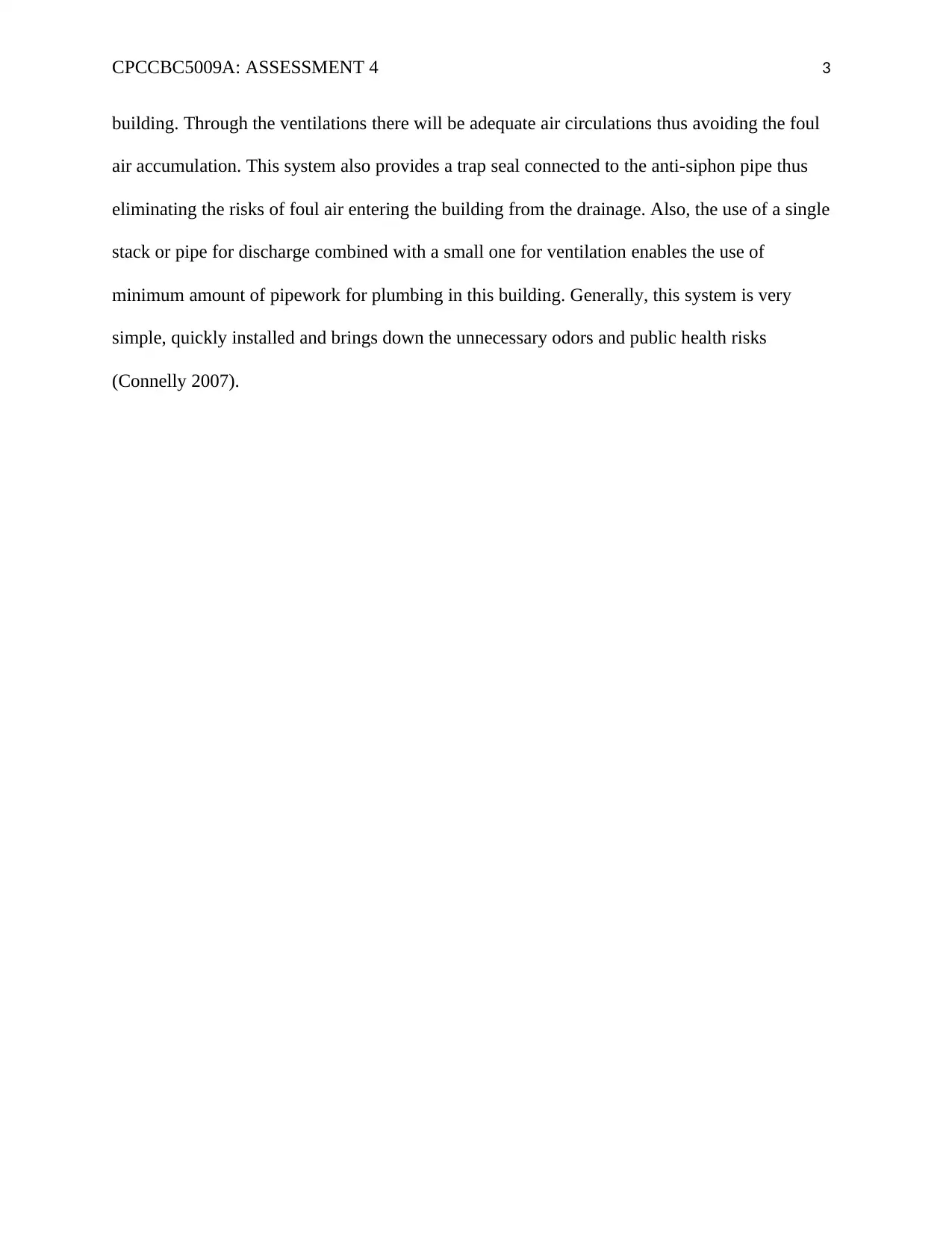
CPCCBC5009A: ASSESSMENT 4 3
building. Through the ventilations there will be adequate air circulations thus avoiding the foul
air accumulation. This system also provides a trap seal connected to the anti-siphon pipe thus
eliminating the risks of foul air entering the building from the drainage. Also, the use of a single
stack or pipe for discharge combined with a small one for ventilation enables the use of
minimum amount of pipework for plumbing in this building. Generally, this system is very
simple, quickly installed and brings down the unnecessary odors and public health risks
(Connelly 2007).
building. Through the ventilations there will be adequate air circulations thus avoiding the foul
air accumulation. This system also provides a trap seal connected to the anti-siphon pipe thus
eliminating the risks of foul air entering the building from the drainage. Also, the use of a single
stack or pipe for discharge combined with a small one for ventilation enables the use of
minimum amount of pipework for plumbing in this building. Generally, this system is very
simple, quickly installed and brings down the unnecessary odors and public health risks
(Connelly 2007).
⊘ This is a preview!⊘
Do you want full access?
Subscribe today to unlock all pages.

Trusted by 1+ million students worldwide
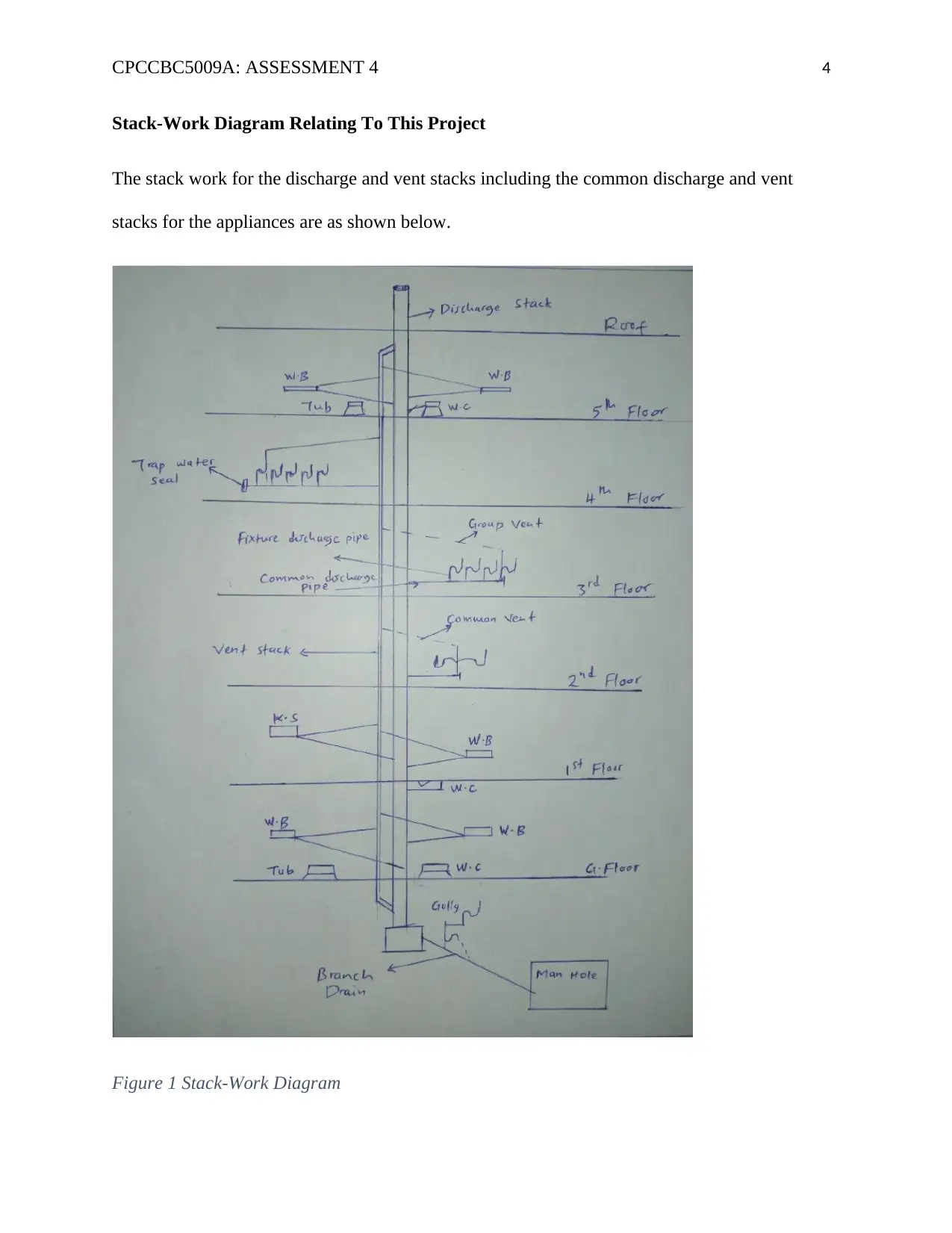
CPCCBC5009A: ASSESSMENT 4 4
Stack-Work Diagram Relating To This Project
The stack work for the discharge and vent stacks including the common discharge and vent
stacks for the appliances are as shown below.
Figure 1 Stack-Work Diagram
Stack-Work Diagram Relating To This Project
The stack work for the discharge and vent stacks including the common discharge and vent
stacks for the appliances are as shown below.
Figure 1 Stack-Work Diagram
Paraphrase This Document
Need a fresh take? Get an instant paraphrase of this document with our AI Paraphraser
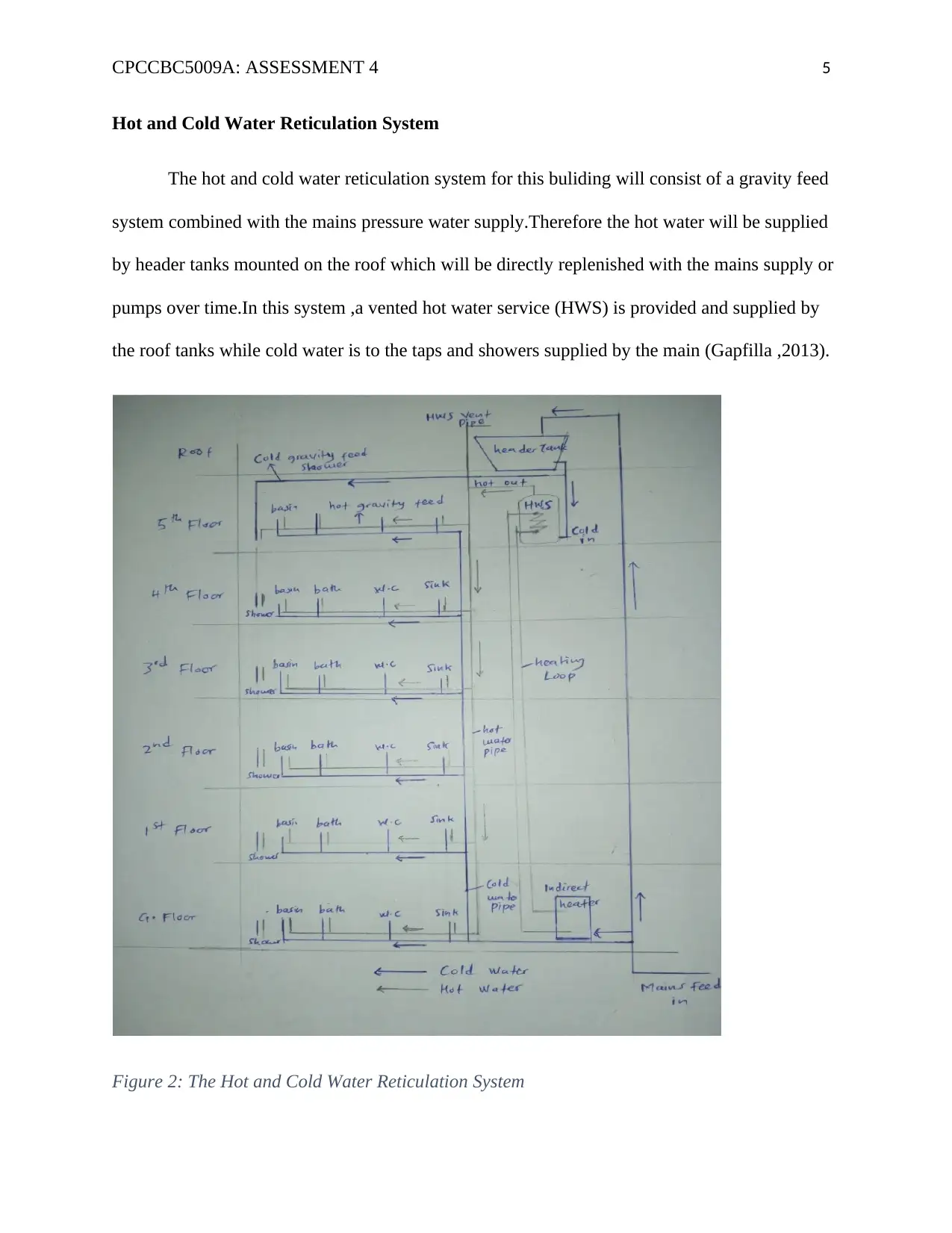
CPCCBC5009A: ASSESSMENT 4 5
Hot and Cold Water Reticulation System
The hot and cold water reticulation system for this buliding will consist of a gravity feed
system combined with the mains pressure water supply.Therefore the hot water will be supplied
by header tanks mounted on the roof which will be directly replenished with the mains supply or
pumps over time.In this system ,a vented hot water service (HWS) is provided and supplied by
the roof tanks while cold water is to the taps and showers supplied by the main (Gapfilla ,2013).
Figure 2: The Hot and Cold Water Reticulation System
Hot and Cold Water Reticulation System
The hot and cold water reticulation system for this buliding will consist of a gravity feed
system combined with the mains pressure water supply.Therefore the hot water will be supplied
by header tanks mounted on the roof which will be directly replenished with the mains supply or
pumps over time.In this system ,a vented hot water service (HWS) is provided and supplied by
the roof tanks while cold water is to the taps and showers supplied by the main (Gapfilla ,2013).
Figure 2: The Hot and Cold Water Reticulation System
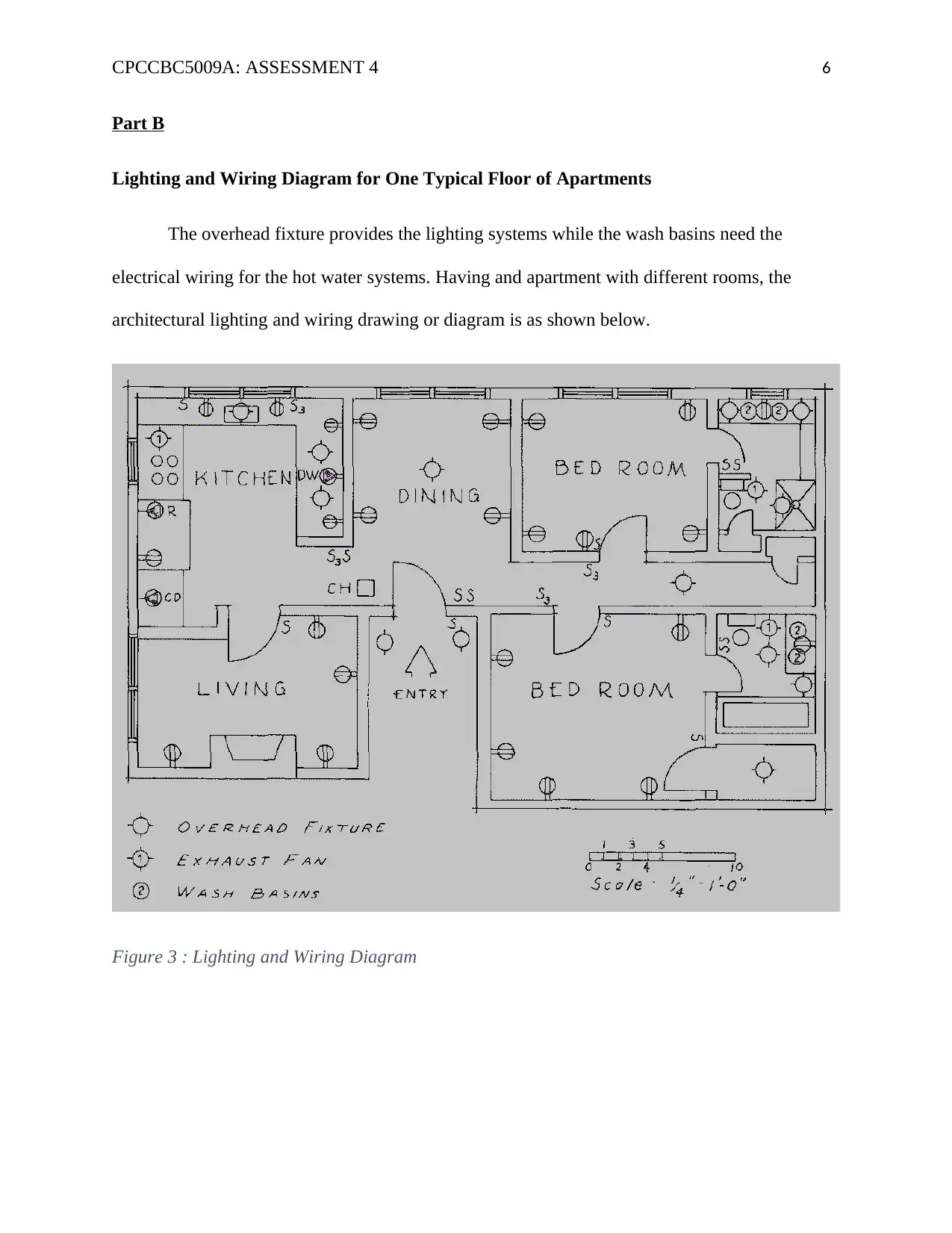
CPCCBC5009A: ASSESSMENT 4 6
Part B
Lighting and Wiring Diagram for One Typical Floor of Apartments
The overhead fixture provides the lighting systems while the wash basins need the
electrical wiring for the hot water systems. Having and apartment with different rooms, the
architectural lighting and wiring drawing or diagram is as shown below.
Figure 3 : Lighting and Wiring Diagram
Part B
Lighting and Wiring Diagram for One Typical Floor of Apartments
The overhead fixture provides the lighting systems while the wash basins need the
electrical wiring for the hot water systems. Having and apartment with different rooms, the
architectural lighting and wiring drawing or diagram is as shown below.
Figure 3 : Lighting and Wiring Diagram
⊘ This is a preview!⊘
Do you want full access?
Subscribe today to unlock all pages.

Trusted by 1+ million students worldwide
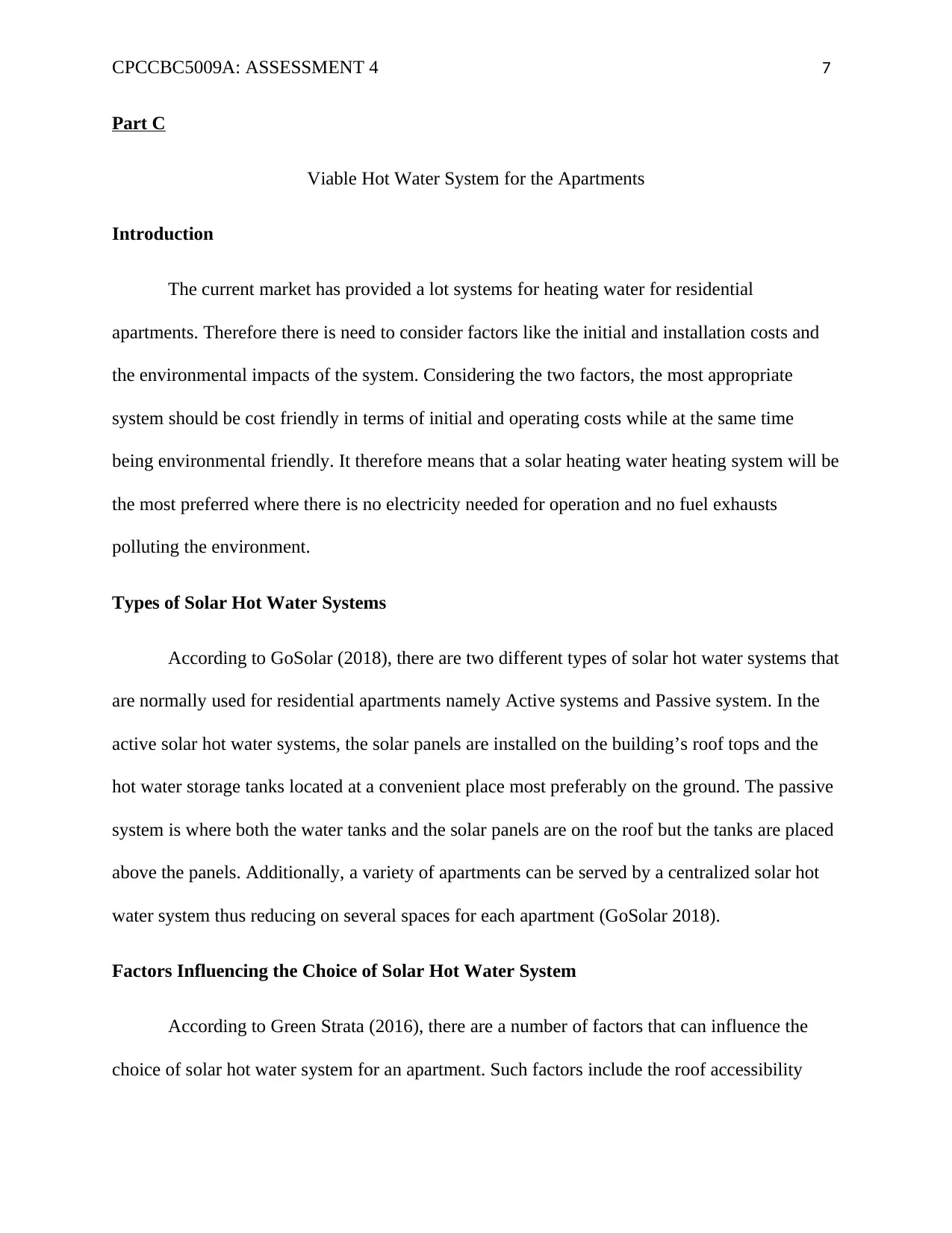
CPCCBC5009A: ASSESSMENT 4 7
Part C
Viable Hot Water System for the Apartments
Introduction
The current market has provided a lot systems for heating water for residential
apartments. Therefore there is need to consider factors like the initial and installation costs and
the environmental impacts of the system. Considering the two factors, the most appropriate
system should be cost friendly in terms of initial and operating costs while at the same time
being environmental friendly. It therefore means that a solar heating water heating system will be
the most preferred where there is no electricity needed for operation and no fuel exhausts
polluting the environment.
Types of Solar Hot Water Systems
According to GoSolar (2018), there are two different types of solar hot water systems that
are normally used for residential apartments namely Active systems and Passive system. In the
active solar hot water systems, the solar panels are installed on the building’s roof tops and the
hot water storage tanks located at a convenient place most preferably on the ground. The passive
system is where both the water tanks and the solar panels are on the roof but the tanks are placed
above the panels. Additionally, a variety of apartments can be served by a centralized solar hot
water system thus reducing on several spaces for each apartment (GoSolar 2018).
Factors Influencing the Choice of Solar Hot Water System
According to Green Strata (2016), there are a number of factors that can influence the
choice of solar hot water system for an apartment. Such factors include the roof accessibility
Part C
Viable Hot Water System for the Apartments
Introduction
The current market has provided a lot systems for heating water for residential
apartments. Therefore there is need to consider factors like the initial and installation costs and
the environmental impacts of the system. Considering the two factors, the most appropriate
system should be cost friendly in terms of initial and operating costs while at the same time
being environmental friendly. It therefore means that a solar heating water heating system will be
the most preferred where there is no electricity needed for operation and no fuel exhausts
polluting the environment.
Types of Solar Hot Water Systems
According to GoSolar (2018), there are two different types of solar hot water systems that
are normally used for residential apartments namely Active systems and Passive system. In the
active solar hot water systems, the solar panels are installed on the building’s roof tops and the
hot water storage tanks located at a convenient place most preferably on the ground. The passive
system is where both the water tanks and the solar panels are on the roof but the tanks are placed
above the panels. Additionally, a variety of apartments can be served by a centralized solar hot
water system thus reducing on several spaces for each apartment (GoSolar 2018).
Factors Influencing the Choice of Solar Hot Water System
According to Green Strata (2016), there are a number of factors that can influence the
choice of solar hot water system for an apartment. Such factors include the roof accessibility
Paraphrase This Document
Need a fresh take? Get an instant paraphrase of this document with our AI Paraphraser
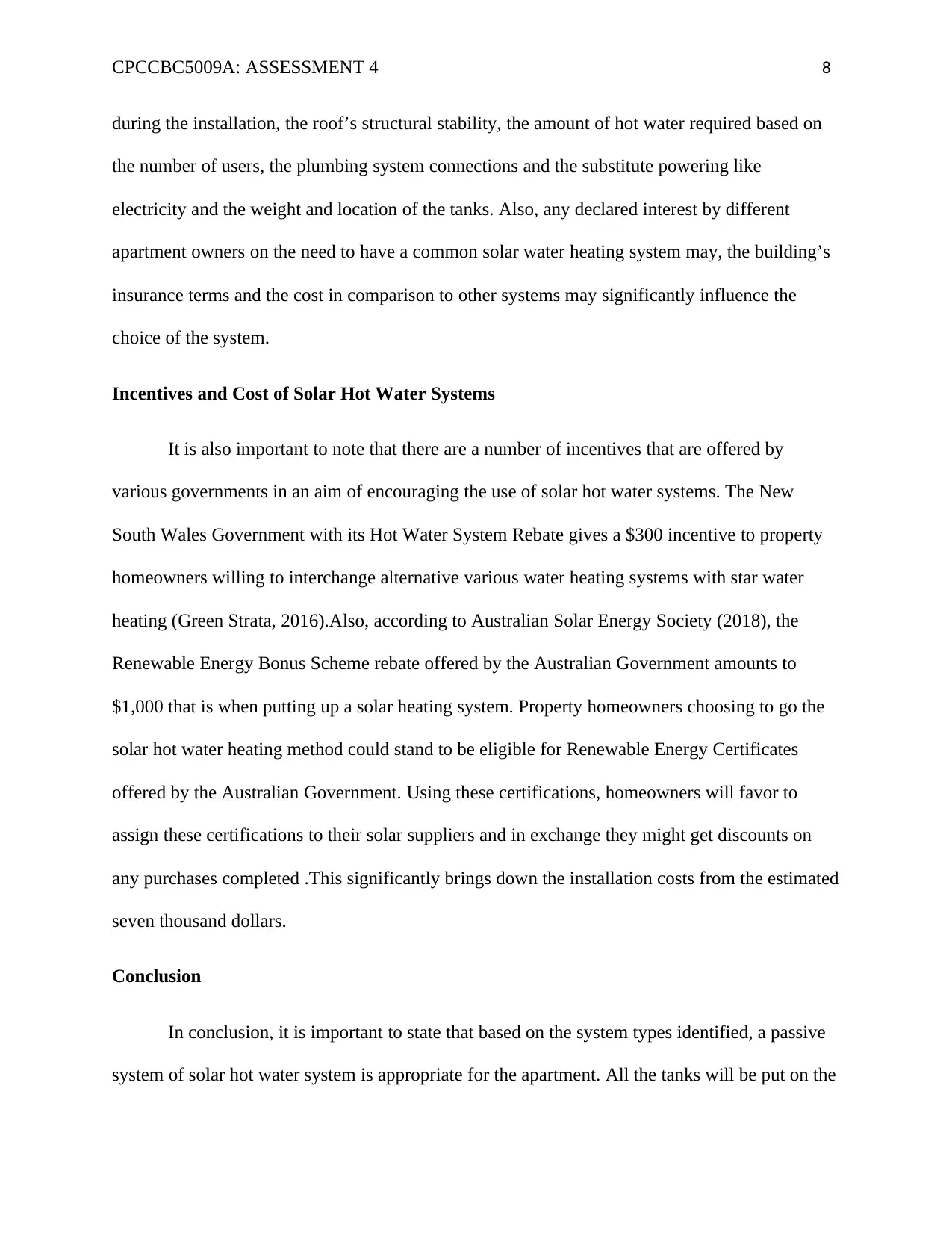
CPCCBC5009A: ASSESSMENT 4 8
during the installation, the roof’s structural stability, the amount of hot water required based on
the number of users, the plumbing system connections and the substitute powering like
electricity and the weight and location of the tanks. Also, any declared interest by different
apartment owners on the need to have a common solar water heating system may, the building’s
insurance terms and the cost in comparison to other systems may significantly influence the
choice of the system.
Incentives and Cost of Solar Hot Water Systems
It is also important to note that there are a number of incentives that are offered by
various governments in an aim of encouraging the use of solar hot water systems. The New
South Wales Government with its Hot Water System Rebate gives a $300 incentive to property
homeowners willing to interchange alternative various water heating systems with star water
heating (Green Strata, 2016).Also, according to Australian Solar Energy Society (2018), the
Renewable Energy Bonus Scheme rebate offered by the Australian Government amounts to
$1,000 that is when putting up a solar heating system. Property homeowners choosing to go the
solar hot water heating method could stand to be eligible for Renewable Energy Certificates
offered by the Australian Government. Using these certifications, homeowners will favor to
assign these certifications to their solar suppliers and in exchange they might get discounts on
any purchases completed .This significantly brings down the installation costs from the estimated
seven thousand dollars.
Conclusion
In conclusion, it is important to state that based on the system types identified, a passive
system of solar hot water system is appropriate for the apartment. All the tanks will be put on the
during the installation, the roof’s structural stability, the amount of hot water required based on
the number of users, the plumbing system connections and the substitute powering like
electricity and the weight and location of the tanks. Also, any declared interest by different
apartment owners on the need to have a common solar water heating system may, the building’s
insurance terms and the cost in comparison to other systems may significantly influence the
choice of the system.
Incentives and Cost of Solar Hot Water Systems
It is also important to note that there are a number of incentives that are offered by
various governments in an aim of encouraging the use of solar hot water systems. The New
South Wales Government with its Hot Water System Rebate gives a $300 incentive to property
homeowners willing to interchange alternative various water heating systems with star water
heating (Green Strata, 2016).Also, according to Australian Solar Energy Society (2018), the
Renewable Energy Bonus Scheme rebate offered by the Australian Government amounts to
$1,000 that is when putting up a solar heating system. Property homeowners choosing to go the
solar hot water heating method could stand to be eligible for Renewable Energy Certificates
offered by the Australian Government. Using these certifications, homeowners will favor to
assign these certifications to their solar suppliers and in exchange they might get discounts on
any purchases completed .This significantly brings down the installation costs from the estimated
seven thousand dollars.
Conclusion
In conclusion, it is important to state that based on the system types identified, a passive
system of solar hot water system is appropriate for the apartment. All the tanks will be put on the
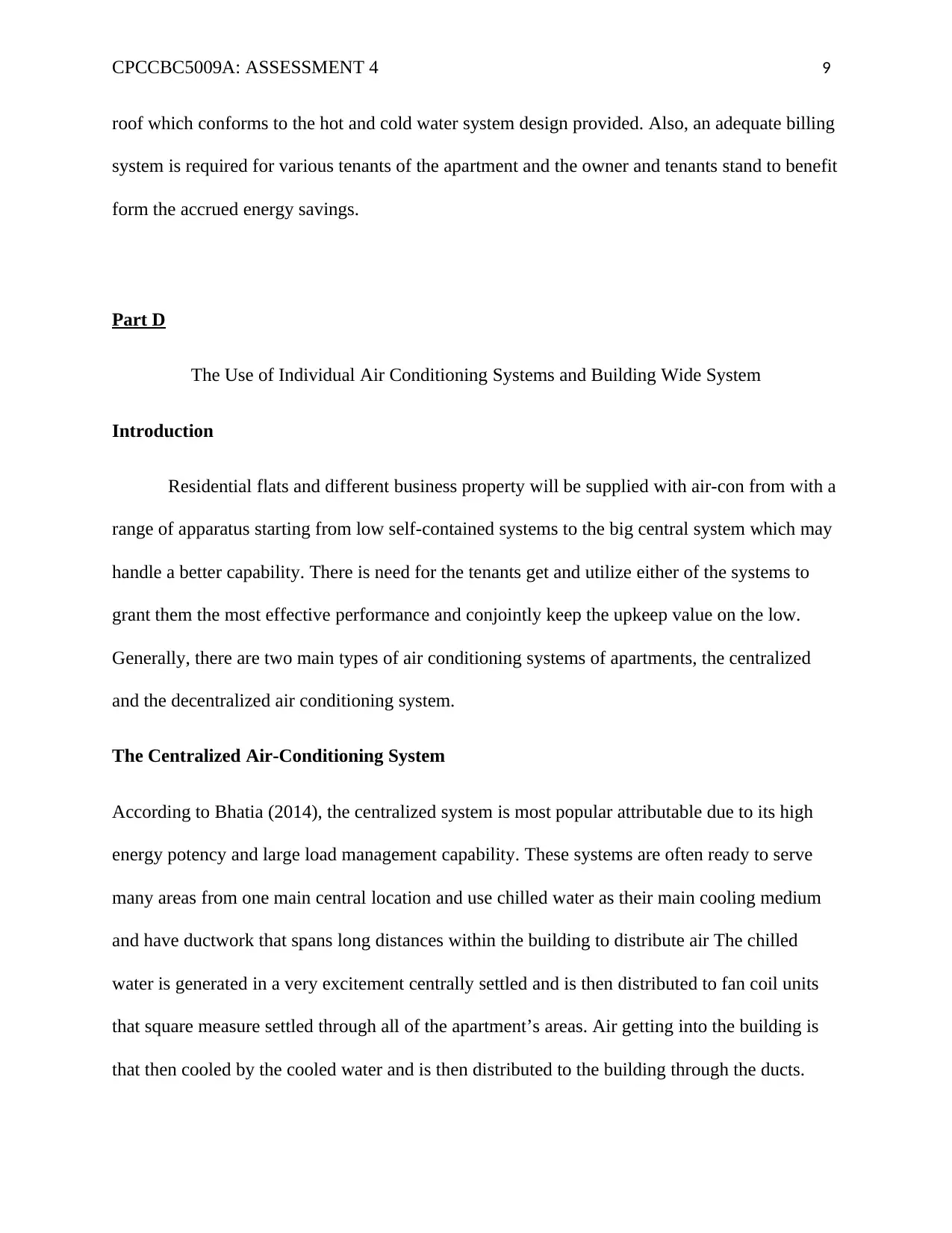
CPCCBC5009A: ASSESSMENT 4 9
roof which conforms to the hot and cold water system design provided. Also, an adequate billing
system is required for various tenants of the apartment and the owner and tenants stand to benefit
form the accrued energy savings.
Part D
The Use of Individual Air Conditioning Systems and Building Wide System
Introduction
Residential flats and different business property will be supplied with air-con from with a
range of apparatus starting from low self-contained systems to the big central system which may
handle a better capability. There is need for the tenants get and utilize either of the systems to
grant them the most effective performance and conjointly keep the upkeep value on the low.
Generally, there are two main types of air conditioning systems of apartments, the centralized
and the decentralized air conditioning system.
The Centralized Air-Conditioning System
According to Bhatia (2014), the centralized system is most popular attributable due to its high
energy potency and large load management capability. These systems are often ready to serve
many areas from one main central location and use chilled water as their main cooling medium
and have ductwork that spans long distances within the building to distribute air The chilled
water is generated in a very excitement centrally settled and is then distributed to fan coil units
that square measure settled through all of the apartment’s areas. Air getting into the building is
that then cooled by the cooled water and is then distributed to the building through the ducts.
roof which conforms to the hot and cold water system design provided. Also, an adequate billing
system is required for various tenants of the apartment and the owner and tenants stand to benefit
form the accrued energy savings.
Part D
The Use of Individual Air Conditioning Systems and Building Wide System
Introduction
Residential flats and different business property will be supplied with air-con from with a
range of apparatus starting from low self-contained systems to the big central system which may
handle a better capability. There is need for the tenants get and utilize either of the systems to
grant them the most effective performance and conjointly keep the upkeep value on the low.
Generally, there are two main types of air conditioning systems of apartments, the centralized
and the decentralized air conditioning system.
The Centralized Air-Conditioning System
According to Bhatia (2014), the centralized system is most popular attributable due to its high
energy potency and large load management capability. These systems are often ready to serve
many areas from one main central location and use chilled water as their main cooling medium
and have ductwork that spans long distances within the building to distribute air The chilled
water is generated in a very excitement centrally settled and is then distributed to fan coil units
that square measure settled through all of the apartment’s areas. Air getting into the building is
that then cooled by the cooled water and is then distributed to the building through the ducts.
⊘ This is a preview!⊘
Do you want full access?
Subscribe today to unlock all pages.

Trusted by 1+ million students worldwide
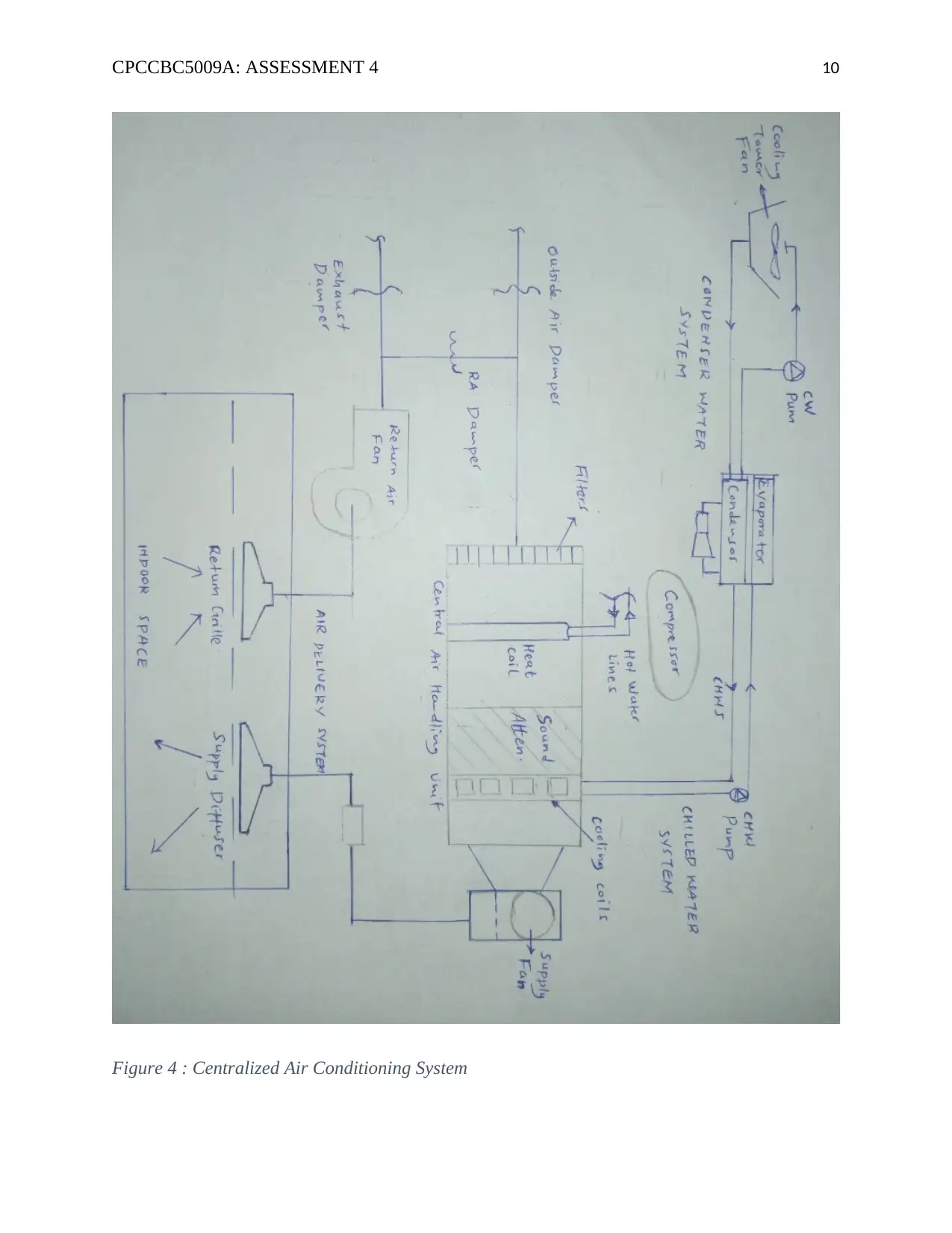
CPCCBC5009A: ASSESSMENT 4 10
Figure 4 : Centralized Air Conditioning System
Figure 4 : Centralized Air Conditioning System
Paraphrase This Document
Need a fresh take? Get an instant paraphrase of this document with our AI Paraphraser
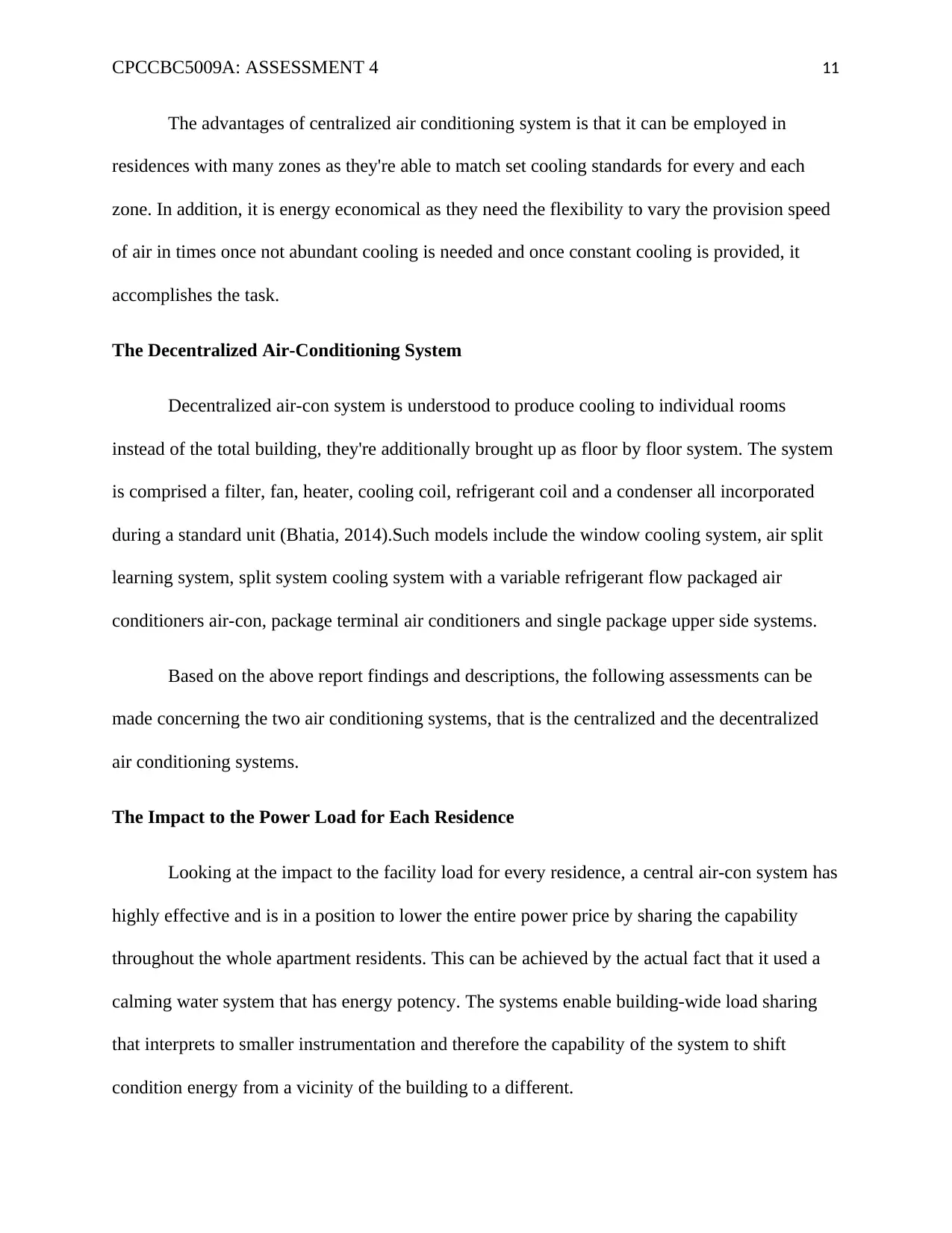
CPCCBC5009A: ASSESSMENT 4 11
The advantages of centralized air conditioning system is that it can be employed in
residences with many zones as they're able to match set cooling standards for every and each
zone. In addition, it is energy economical as they need the flexibility to vary the provision speed
of air in times once not abundant cooling is needed and once constant cooling is provided, it
accomplishes the task.
The Decentralized Air-Conditioning System
Decentralized air-con system is understood to produce cooling to individual rooms
instead of the total building, they're additionally brought up as floor by floor system. The system
is comprised a filter, fan, heater, cooling coil, refrigerant coil and a condenser all incorporated
during a standard unit (Bhatia, 2014).Such models include the window cooling system, air split
learning system, split system cooling system with a variable refrigerant flow packaged air
conditioners air-con, package terminal air conditioners and single package upper side systems.
Based on the above report findings and descriptions, the following assessments can be
made concerning the two air conditioning systems, that is the centralized and the decentralized
air conditioning systems.
The Impact to the Power Load for Each Residence
Looking at the impact to the facility load for every residence, a central air-con system has
highly effective and is in a position to lower the entire power price by sharing the capability
throughout the whole apartment residents. This can be achieved by the actual fact that it used a
calming water system that has energy potency. The systems enable building-wide load sharing
that interprets to smaller instrumentation and therefore the capability of the system to shift
condition energy from a vicinity of the building to a different.
The advantages of centralized air conditioning system is that it can be employed in
residences with many zones as they're able to match set cooling standards for every and each
zone. In addition, it is energy economical as they need the flexibility to vary the provision speed
of air in times once not abundant cooling is needed and once constant cooling is provided, it
accomplishes the task.
The Decentralized Air-Conditioning System
Decentralized air-con system is understood to produce cooling to individual rooms
instead of the total building, they're additionally brought up as floor by floor system. The system
is comprised a filter, fan, heater, cooling coil, refrigerant coil and a condenser all incorporated
during a standard unit (Bhatia, 2014).Such models include the window cooling system, air split
learning system, split system cooling system with a variable refrigerant flow packaged air
conditioners air-con, package terminal air conditioners and single package upper side systems.
Based on the above report findings and descriptions, the following assessments can be
made concerning the two air conditioning systems, that is the centralized and the decentralized
air conditioning systems.
The Impact to the Power Load for Each Residence
Looking at the impact to the facility load for every residence, a central air-con system has
highly effective and is in a position to lower the entire power price by sharing the capability
throughout the whole apartment residents. This can be achieved by the actual fact that it used a
calming water system that has energy potency. The systems enable building-wide load sharing
that interprets to smaller instrumentation and therefore the capability of the system to shift
condition energy from a vicinity of the building to a different.
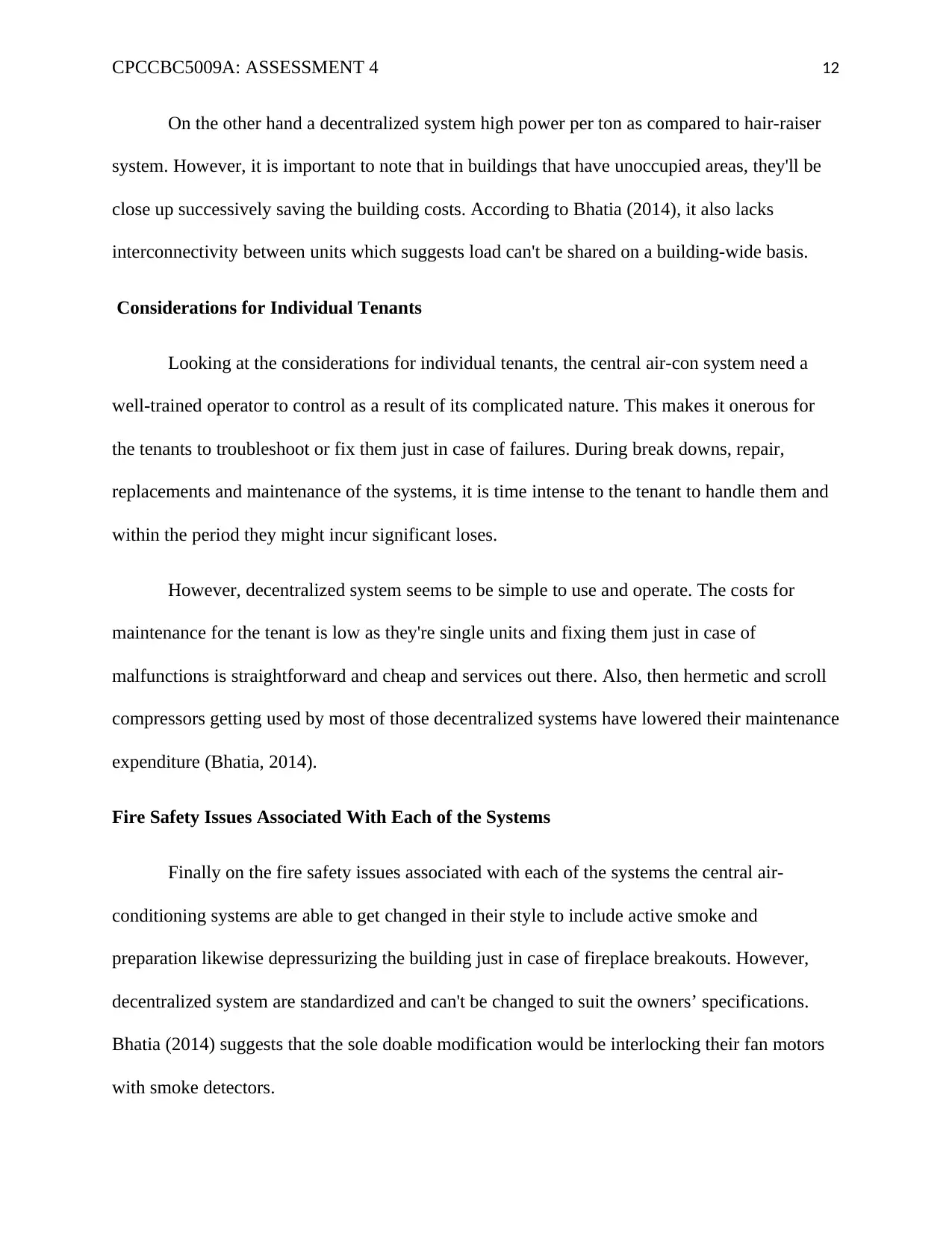
CPCCBC5009A: ASSESSMENT 4 12
On the other hand a decentralized system high power per ton as compared to hair-raiser
system. However, it is important to note that in buildings that have unoccupied areas, they'll be
close up successively saving the building costs. According to Bhatia (2014), it also lacks
interconnectivity between units which suggests load can't be shared on a building-wide basis.
Considerations for Individual Tenants
Looking at the considerations for individual tenants, the central air-con system need a
well-trained operator to control as a result of its complicated nature. This makes it onerous for
the tenants to troubleshoot or fix them just in case of failures. During break downs, repair,
replacements and maintenance of the systems, it is time intense to the tenant to handle them and
within the period they might incur significant loses.
However, decentralized system seems to be simple to use and operate. The costs for
maintenance for the tenant is low as they're single units and fixing them just in case of
malfunctions is straightforward and cheap and services out there. Also, then hermetic and scroll
compressors getting used by most of those decentralized systems have lowered their maintenance
expenditure (Bhatia, 2014).
Fire Safety Issues Associated With Each of the Systems
Finally on the fire safety issues associated with each of the systems the central air-
conditioning systems are able to get changed in their style to include active smoke and
preparation likewise depressurizing the building just in case of fireplace breakouts. However,
decentralized system are standardized and can't be changed to suit the owners’ specifications.
Bhatia (2014) suggests that the sole doable modification would be interlocking their fan motors
with smoke detectors.
On the other hand a decentralized system high power per ton as compared to hair-raiser
system. However, it is important to note that in buildings that have unoccupied areas, they'll be
close up successively saving the building costs. According to Bhatia (2014), it also lacks
interconnectivity between units which suggests load can't be shared on a building-wide basis.
Considerations for Individual Tenants
Looking at the considerations for individual tenants, the central air-con system need a
well-trained operator to control as a result of its complicated nature. This makes it onerous for
the tenants to troubleshoot or fix them just in case of failures. During break downs, repair,
replacements and maintenance of the systems, it is time intense to the tenant to handle them and
within the period they might incur significant loses.
However, decentralized system seems to be simple to use and operate. The costs for
maintenance for the tenant is low as they're single units and fixing them just in case of
malfunctions is straightforward and cheap and services out there. Also, then hermetic and scroll
compressors getting used by most of those decentralized systems have lowered their maintenance
expenditure (Bhatia, 2014).
Fire Safety Issues Associated With Each of the Systems
Finally on the fire safety issues associated with each of the systems the central air-
conditioning systems are able to get changed in their style to include active smoke and
preparation likewise depressurizing the building just in case of fireplace breakouts. However,
decentralized system are standardized and can't be changed to suit the owners’ specifications.
Bhatia (2014) suggests that the sole doable modification would be interlocking their fan motors
with smoke detectors.
⊘ This is a preview!⊘
Do you want full access?
Subscribe today to unlock all pages.

Trusted by 1+ million students worldwide
1 out of 15
Related Documents
Your All-in-One AI-Powered Toolkit for Academic Success.
+13062052269
info@desklib.com
Available 24*7 on WhatsApp / Email
![[object Object]](/_next/static/media/star-bottom.7253800d.svg)
Unlock your academic potential
Copyright © 2020–2025 A2Z Services. All Rights Reserved. Developed and managed by ZUCOL.


